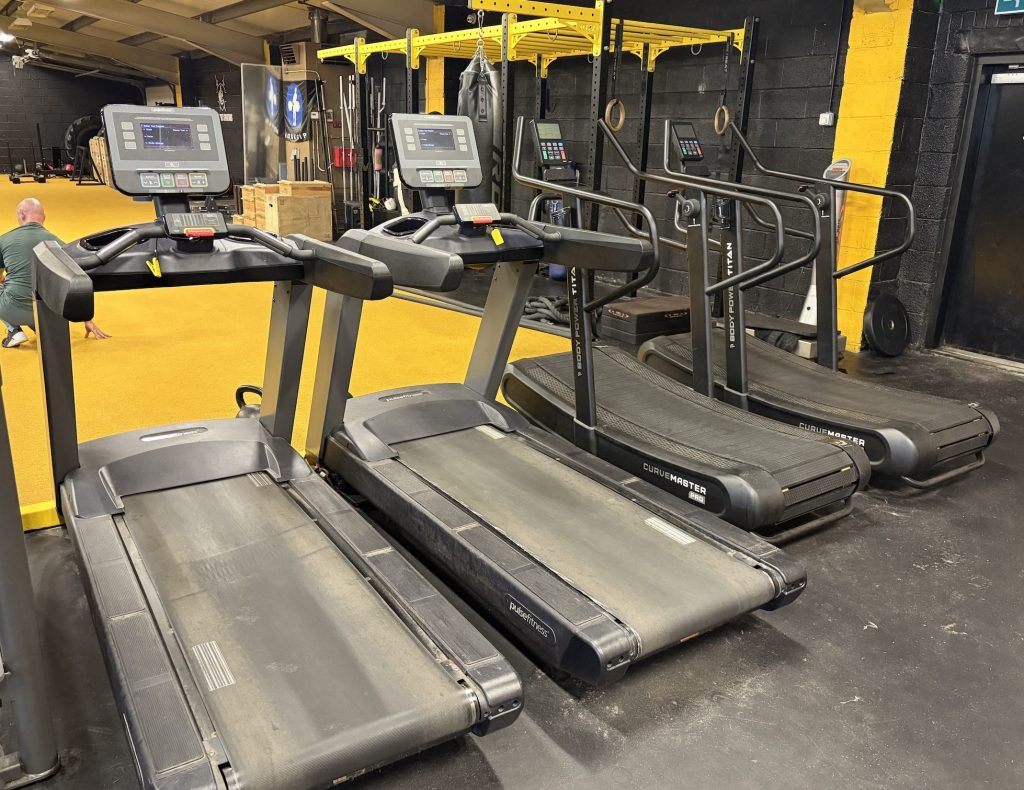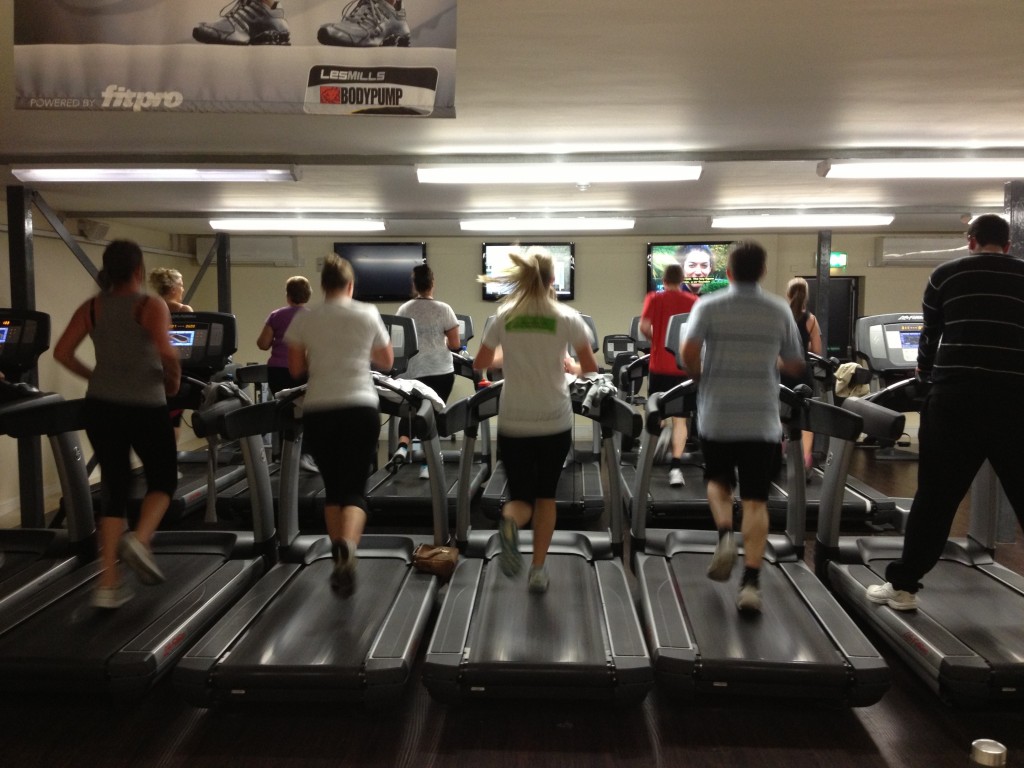Curved Treadmill vs Traditional Flat Treadmill – Which One, and Why?
In a comparison of curved treadmill vs traditional flat treadmill, which one is the better choice?
As always in fitness, the answer is ‘it depends’. That’s a crappy answer though, so I’m going to break down the curved treadmill vs traditional flat treadmill debate for you. I’m going go through them both to answer which treadmill you should get, and why.
I’m uniquely qualified to answer this, because I’ve got both types of treadmills in MyGym.
The Main Benefits of Curved Over Traditional Treadmills
Aside from the obvious (shape), there are many differences between curved treadmills and traditional treadmills. Here’s a snapshot of the main ones…
Curved treadmills are self-powered
With a traditional treadmill the belt is driven by a motor, and you need to run to keep up. With a curved treadmill it’s the opposite – the belt only moves because you force it to move with your running. The belt speed is governed by your running speed, and not the other way around like on a traditional treadmill.
This is a slight disadvantage to lighter runners, because you don’t have as much mass to ‘drag’ the belt around. It means a lighter runner has to work even harder to get the machine going, then keep it going.

Curved treadmills make you work harder
If you’re used both and perceived that the curved treadmill (often known as non-motorised)was harder, you’d be right.
A study published in the ‘Frontiers in Physiology Journal‘ concluded…
‘… results of the current study demonstrate that at any given submaximal speed, running on a non-motorised treadmill provides a markedly higher cardiometabolic stress compared to running on either a motorised treadmill or overground.’
In English, this means that if you ran at the same speed on either type of treadmill, you’d be working harder on the curved treadmill.
Curved Treadmill Allows a More Natural Gait
This is purely anecdotal, but running on a curved treadmill feels far smoother and more natural. The curved surface doesn’t allow for the foot ‘slap’ that some runners experience on a perfectly flat surface.
Whether or not that leads to lower injury frequency, I’m not sure. I’m not aware of any high-quality research into the topic. It certainly feels like it would be the case though. I’ve seen and heard plenty of awful running on a traditional treadmill, but I’ve never seen it on a curved treadmill!
Curved Treadmill Running Costs Are Lower
That’s not a pun.
You don’t plug a curved treadmill into anything. It’s completely self-powered, so you can relax on your electricity bills going up. If you’re plugging a high-powered electric treadmill, running at high speed, using the integrated TV and fan, then that’s going to add to the electricity bill pretty quickly!
Better for Speed Changes
When you perform a variable speed workout on a traditional flat treadmill, you’ve got one of two choices – you either spend ages setting up the intervals, or you risk life and limb pressing buttons on a screen mid-sprint when you need to slow down.
On a curved treadmill, you have none of that. You simply adjust your running speed. If you want to sprint, you just sprint. If you want to slow down, you slow down. No delays, no buttons to press – you’re in complete control.

Problems With Curved Treadmills
No technology is without its problems, and curved treadmills have issues too. Here’s a few of the more obvious ones…
Harder for lighter users to gain speed
The machine is user-driven, and it’s much easier to generate speed when you’re heavier. If you’re less than 60kg, it’s going to be tough.
I first noticed this when my teenage son was doing a sprint interval session on my curved treadmill. Despite being pretty quick usually, he simply didn’t weigh enough (48kg) to get the machine moving fast enough to sprint.
If you don’t weigh much, avoid a curved treadmill for sprint sessions. Longer duration runs may be challenging too.
No incline facility
A curved treadmill doesn’t allow an incline facility, both because of its design and the nature of the belt. If you had an incline on a curved treadmill, it’d mean tipping the machine – that would create a situation where your legs would keep increasing with speed until you reached a point where you lost control, almost like a cartoon!
You can increase the drag on a curved treadmill, which is how they make a workout harder without increasing speed.
Displays not interactive
One of the advances in treadmill technology over the years is the screen. Nowadays on the higher end treadmills the screen is interactive – it might include a TV, different running routes, a web browser etc. If you use those features, don’t get a curved treadmill!
I’m yet to see a curved treadmill with anything but a basic LCD screen, containing the usual basic workout data such as speed, time, distance, calories etc.
The lack of interactive user screen is likely down to the lack of external power supply, so it’s probably not going to appear on curved treadmills any time soon either.
Can’t save workout data
An extension of the lack of screen technology is the inability to save workout data.
This isn’t likely to be a big deal in a gym – you won’t be saving your workout data on a public treadmill, but it could be a concern to a home user. If you don’t save your workout data, it’s not a problem. A concern worth noting if you’re a workout data/diary kind of person.
More difficult to maintain a set speed
If you’re a steady-state runner, you can set a traditional treadmill to a speed and get on with it. You’ll maintain that speed until you tell the machine otherwise. That’s not quite the case with a curved treadmill.
With a curved treadmill you’re in control of the speed, so you might find it more difficult to set the speed and get on with it. Not a concern for some, but a big concern for others.

Curved Treadmill vs Traditional Flat Treadmill – Final Thoughts
When looking at the curved treadmill vs traditional flat treadmill debate, you’ve got to consider the use cases. There’s a place for both, so it depends on what you’re doing and when.
If you like to go on long runs, at a stead pace and use all of the interactive features on the display, you’d be best off going for a traditional flat treadmill. If you like the incline feature, you’re going to need a traditional flat treadmill. If you’re particularly light, a traditional flat treadmill will make life easier too.
If you’re not likely to use a treadmill for hour-long runs, and like the variety of sprints, HIIT, short runs and the efficiency of the curve, go with a curved treadmill. If you want a more natural gait, and lower running and maintenance costs, go with a curved treadmill. If you’re a CrossFit athlete, a HYROX athlete, or perform any kind of sport requiring short sprints, I’d go with a curved treadmill.
So there’s my take on the curved treadmill vs traditional flat treadmill debate. As with any fitness question there’s nuance to the answer, but hopefully this post has armed you with enough information to make a good decision.
If you want to follow me and my life in more detail, come and catch me on Instagram!